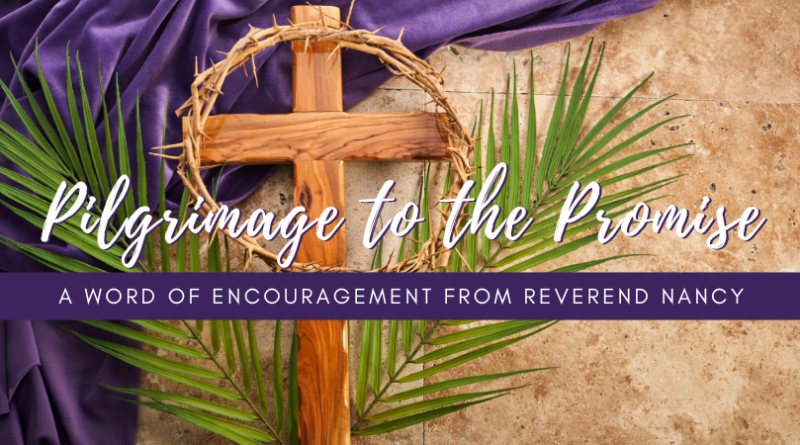Pilgrimage to the Promise
In Holy Week, Christians symbolically walk through the last week of Jesus’ life. Holy Week observances have their roots in pilgrimages faithful Christians undertook to Jerusalem, pilgrimages that focused on the events in Jerusalem. Our own pilgrimage through Holy Week is marked by Jesus’ experiences, but always from the perspective of knowing the promise of resurrection is fulfilled.
Holy Week begins with Palm Sunday/The Sunday of the Passion, beginning with Jesus’ triumphant entry into Jerusalem amid pilgrims gathered for Passover. Just as that joyful occasion soon collapsed into tragedy, so does the mood this Sunday shift rapidly with a reading of the Passion (one of the gospel accounts of Jesus’ arrest and crucifixion). At All Saints’, we start Palm Sunday by gathering outside with palms and Hosannas(translated “Save, Please”) connecting with Jesus’ triumphant entry into Jerusalem. Worship ends in silent contemplation.
Services on Monday, Tuesday, and Wednesday each focus on an event of the week following Jesus’ jubilant entry. Monday, Jesus is anointed by Mary. Tuesday, Jesus responds to the request of “some Greeks at the festival,” who wanted to see Jesus. Wednesday, we grapple with Judas’ betrayal.
Thursday, known as Maundy Thursday (Maundy from maundatum, command) retells the story of Jesus’ last meal with his disciples, his time of prayer, arrest, and trial. At All Saints’ the whole community gathers for a meal, which includes washing of feet, dinner, and Eucharist. The mood is celebratory, but again shifts dramatically with the stripping of the altar, symbolizing Jesus’ humiliation at the hands of the Roman soldiers. After the service is a Prayer Vigil where we personally respond to Jesus’ question to his disciples, “Could you not watch with me one hour?”
Friday, known as Good Friday (not because what happens to Jesus was good, but in the sense of good as “serious, pious, or holy”) is the day of Jesus’ crucifixion. Stations of the Cross follow the ancient custom of pilgrims to Jerusalem who walk the Via Dolorosa (the way of sorrow), the path Jesus took from his sentencing to the place of crucifixion. This year there are three different offerings. For families with children, there are Stations of the Cross in the morning. All through Lent, the opportunity to walk the Stations of the Cross is available in the garden area (off the upper parking lot). Also, mid-afternoon on Good Friday, there is a community Stations of the Cross which provides the chance to pray for different aspects of our life together. At Noon on Good Friday, we hear the Passion story and pray for the needs of the world for which Jesus died. In the evening in the Nave is a reflection on the last words of Jesus as recorded in scripture.
Saturday begins in silence. Jesus has died and was entombed. His friends were shocked and confused: their walk with Jesus came to an abrupt and horrifying end. As Jewish days are counted from sunset, Easter begins that evening with the Easter Vigil. We gather to tell the story of God’s great saving acts in human history culminating with the resurrection of Jesus. We have two Easter Vigil offerings, an earlier one especially for families with children, and a later vigil supported by the Choir of All Saints’.
Sunday is Easter Sunday, the day we celebrate the fulfillment of the promise God made – new life through the resurrection of Jesus! The celebration begins Easter Sunday, but Easter is a season. Each Sunday in the season of Easter we tell more and more stories of the community that formed after Jesus’ resurrection.
Nancy+

